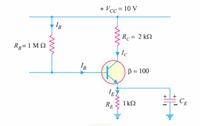
Introductory Circuit Analysis (13th Edition)
13th Edition
ISBN: 9780133923605
Author: Robert L. Boylestad
Publisher: PEARSON
expand_more
expand_more
format_list_bulleted
Concept explainers
Question
Q22.
Calculate the values of three currents in the circuit shown in the figure.

Transcribed Image Text:+ Vcc= 10 V
IB
Rc= 2 k2
R3=1 M Q
Ic
IB
B = 100
IE
1 kQ
CE
RE
Expert Solution
This question has been solved!
Explore an expertly crafted, step-by-step solution for a thorough understanding of key concepts.
Step by stepSolved in 3 steps with 3 images

Knowledge Booster
Learn more about
Need a deep-dive on the concept behind this application? Look no further. Learn more about this topic, electrical-engineering and related others by exploring similar questions and additional content below.Similar questions
- Needs Complete typed solution with 100 % accuracy.arrow_forwardSuppose the three branch currents in this circuit are I₁ = -3 A, I₂ = -18 A, and I3 = -15 A. The voltage drop across each circuit element is as given in the table below. From this information, determine, for each of these circuit elements, (i) whether an active or passive sign convention is being used for that element, (ii) whether that element is absorbing or producing a net (positive) amount of electrical power. In each answer box within the table below, type the correct choice from among the bold-faced words above. V₂ B A B A C D 1₁ A B 1₂ 1₂ + Circuit element Voltage drop Sign convention? Absorbing or producing net electrical power? -9 V -2 V C 9 V -11 V Darrow_forwardAlternating current is __________. Select one: A. AN ALTERNATING FLOW OF ELECTRONS B. ELECTRONS REVERSING THEIR FLOW AT REGULAR INTERVALS C. THE MOST COMMONLY USED CURRENT D. ALL OF THE ABOVEarrow_forward
- Can you explain the process for solving for the three currents using the equations found?arrow_forwardIn solving a network, what rule must you observe when writing KCL equations? Why?arrow_forwardQ1) What is current in terms of charge? a) Current is measured 2A in a DC circuit * How much charge is involved in the process? * How many electrons are involved in the process? * The voltage source of this current is 12 Volts. What is the power produced by the source?arrow_forward
- How is concept of voltage in electrical circuits is related to the concept of energyarrow_forwardCan you please help me with this problem?arrow_forwardFor the network shown in Figure B22 , assume E = 17V,Diode Di, D2 as Germanium R1=2KQ and R2=3K2. Calculate, i. Current I1, ii. Current ID2 ii. Voltage across resistor R2 R1 Di + E D2 I2 R, Figure B22arrow_forward
arrow_back_ios
arrow_forward_ios
Recommended textbooks for you
 Introductory Circuit Analysis (13th Edition)Electrical EngineeringISBN:9780133923605Author:Robert L. BoylestadPublisher:PEARSON
Introductory Circuit Analysis (13th Edition)Electrical EngineeringISBN:9780133923605Author:Robert L. BoylestadPublisher:PEARSON Delmar's Standard Textbook Of ElectricityElectrical EngineeringISBN:9781337900348Author:Stephen L. HermanPublisher:Cengage Learning
Delmar's Standard Textbook Of ElectricityElectrical EngineeringISBN:9781337900348Author:Stephen L. HermanPublisher:Cengage Learning Programmable Logic ControllersElectrical EngineeringISBN:9780073373843Author:Frank D. PetruzellaPublisher:McGraw-Hill Education
Programmable Logic ControllersElectrical EngineeringISBN:9780073373843Author:Frank D. PetruzellaPublisher:McGraw-Hill Education Fundamentals of Electric CircuitsElectrical EngineeringISBN:9780078028229Author:Charles K Alexander, Matthew SadikuPublisher:McGraw-Hill Education
Fundamentals of Electric CircuitsElectrical EngineeringISBN:9780078028229Author:Charles K Alexander, Matthew SadikuPublisher:McGraw-Hill Education Electric Circuits. (11th Edition)Electrical EngineeringISBN:9780134746968Author:James W. Nilsson, Susan RiedelPublisher:PEARSON
Electric Circuits. (11th Edition)Electrical EngineeringISBN:9780134746968Author:James W. Nilsson, Susan RiedelPublisher:PEARSON Engineering ElectromagneticsElectrical EngineeringISBN:9780078028151Author:Hayt, William H. (william Hart), Jr, BUCK, John A.Publisher:Mcgraw-hill Education,
Engineering ElectromagneticsElectrical EngineeringISBN:9780078028151Author:Hayt, William H. (william Hart), Jr, BUCK, John A.Publisher:Mcgraw-hill Education,

Introductory Circuit Analysis (13th Edition)
Electrical Engineering
ISBN:9780133923605
Author:Robert L. Boylestad
Publisher:PEARSON

Delmar's Standard Textbook Of Electricity
Electrical Engineering
ISBN:9781337900348
Author:Stephen L. Herman
Publisher:Cengage Learning

Programmable Logic Controllers
Electrical Engineering
ISBN:9780073373843
Author:Frank D. Petruzella
Publisher:McGraw-Hill Education

Fundamentals of Electric Circuits
Electrical Engineering
ISBN:9780078028229
Author:Charles K Alexander, Matthew Sadiku
Publisher:McGraw-Hill Education

Electric Circuits. (11th Edition)
Electrical Engineering
ISBN:9780134746968
Author:James W. Nilsson, Susan Riedel
Publisher:PEARSON

Engineering Electromagnetics
Electrical Engineering
ISBN:9780078028151
Author:Hayt, William H. (william Hart), Jr, BUCK, John A.
Publisher:Mcgraw-hill Education,